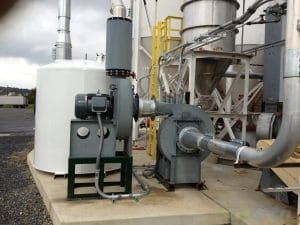SysTech Design supplies equipment for industrial ventilation projects; as a result it is not unusual for us to simply quote exactly what a client requests. Responding to a request for quote from a client in Baltimore, Maryland, we prepared our proposal based on the client specifications for a material conveying project. However, after client conversations, we found various reasons why the client’s original specifications and our written proposal had to be adjusted.
For this project, we received a request for a product conveying application with a vacuum requirement of 3500 Cubic Feet per Minute at 100 Inches Water Gauge, with on-site delivery as soon as possible. We submitted a proposal for a multi-stage exhauster to meet the performance requirements and one that would be a good fit for the application. The product manufacturer we offered was high quality, utilized a TEFC 230/460 motor and regularly delivered on time. Not to mention a nice submittal package for installation and mounting instructions.
However, it was brought to our attention that low price and quick delivery were the “key” deciding factors for this project. Recognizing that multi-stage blowers required more time to produce and because of their mechanical complexity are costlier, we looked at past alternatives to generating similar performance with different technology. Our solution was to use the two fans (industrial exhausters) in series model to achieve higher static pressure (SP) through “standard” single-stage centrifugal exhausters.
Advantages of Two Fans in Series Approach

To meet the delivery need of the client, the two HP exhausters offered a two-week turnaround, while the alternative multi-stage blower would have taken six weeks to be delivered.
Considerations When Using Fans in Series
If given a choice, lower horsepower is always a primary factor in fan/equipment selection. We always strive to minimize energy consumption with our projects, but the customer-defined demands of this project (delivery and low initial cost) to keep a temporary system in operation, outweighed any benefit to motor size. Each exhauster in the series required 48 BHP (50 HP Motor for each blower required), whereas the multi-stage blower would have used a single 75 HP motor. This difference in horsepower requirement is not always the case, however in this instance, it was.
Other factors that must be considered are the available footprint for the equipment, the interconnecting ductwork, and electrical considerations for running power to each motor and disconnects.
Typically, based on the client’s original specifications we would have recommended the single multistage exhauster, but due to the additional requirements, using two single-stage exhausters was the way to go for this application. Need someone who can find the right solution to fit your budget without compromising quality or time constraints? Call us today at 800-456-9460.


